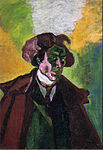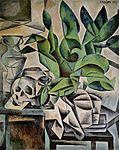art.wikisort.org - Artist
Bohumil Kubišta (21 August 1884 in Vlčkovice, Bohemia – 27 November 1918 in Prague)[1] was a Czech painter and art critic, one of the founders of Czech modern painting. He studied at the Academy of Fine Arts in Prague, but left in 1906 to study at the Reale Istituto di Belle Arti in Florence. He,[1] Emil Filla, Antonín Procházka, and five others founded Osma (The Eight), an Expressionist-oriented group of artists.
This article needs additional citations for verification. (May 2013) |

Work
Kubišta came to his individual expression gradually, at first he was influenced by the work of Vincent van Gogh and Paul Cézanne. He educated himself in philosophy and optics, and studied colour and the geometrical construction of painting.
Kubišta, like several other Czech artists of his generation, was strongly affected by the 1905 Edvard Munch exhibition in Prague. Together with Emil Filla he established the artistic group Osma[2] in 1906 or 1907. He worked in an Expressionist style until 1910, and exchanged ideas with German painters in Die Brücke. He also developed visual ideas learned from the work of Cézanne. His later style (approximately from 1911) was strongly influenced by Expressionism and Cubism. Expressionist elements, particularly his use of colour but also his subject matter, immediately distinguish Kubišta's Cubist work (such as his 1912 St Sebastian) from that of founding Paris Cubists Picasso, Braque and the Section d'Or. He studied colour theory, analyzing the harmonic and compositional principles of painters such as El Greco, Eugène Delacroix, Vincent van Gogh, and Edvard Munch. He also paid close attention to mathematical and geometric principles. Around 1911, he became acquainted with Jan Zrzavý and the artistic group Sursum.
Kubišta joined the army in 1913.[1] He died during the global 1918 flu pandemic[1] which ravaged Europe during and after the First World War.
Paintings
- Self-portrait, 1908
- Still life with Skull, 1912
- St Sebastian, 1912
- Fakir Taming Snakes, 1915
- kiss of a death,1912
References and sources
- References
- Chilvers, Ian, and John Glaves-Smith. "Kubišta, Bohumil." in A Dictionary of Modern and Contemporary Art. Oxford University Press, 2009. Oxford Reference. Accessed 15 June 2013.
- Chilvers, Ian, and John Glaves-Smith. "Eight, The." in A Dictionary of Modern and Contemporary Art. Oxford University Press, 2009. Oxford Reference. Accessed 16 June 2013.
- Sources
- Nešlehová, Mahulena: Bohumil Kubišta. Prague: Odeon, 1984.
- Černá, Marie: Dějiny výtvarného umění. Prague: Idea Servis, 2005. ISBN 80-85970-48-1
- Jörg Deuter, Zweimal Prager Frühling. Über eine Ausstellung, die nicht sein durfte, und über Bohumil Kubista und die Maler der "Brücke". Buchholz 2019. ISBN 978-3-933077-60-8
External links
На других языках
- [en] Bohumil Kubišta
[es] Bohumil Kubišta
Bohumil Kubišta (Vlčkovice, 21 de agosto de 1884-Praga, 27 de noviembre de 1918) fue un pintor checo. Su obra estuvo a caballo entre el expresionismo y el cubismo. Influido por Van Gogh y Cézanne, fue miembro temporalmente del grupo expresionista alemán Die Brücke. De formación autodidacta e interesado por la filosofía y la óptica, estudió los colores y la construcción geométrica de la pintura. Junto con Emil Filla fundó el grupo artístico Osma en 1907. Su obra evolucionó desde 1911 a un estilo más influido por el cubismo. Murió durante la pandemia de la gripe de 1918.[1][fr] Bohumil Kubišta
Bohumil Kubišta, né le 21 août 1884 à Vlčkovice en Autriche-Hongrie et mort le 27 novembre 1918 (à 34 ans) à Prague, est un peintre tchèque.[ru] Кубишта, Богумил
Богумил Кубишта (чеш. Bohumil Kubišta; 1884, Влчковице — 1918, Прага) — чешский художник.Другой контент может иметь иную лицензию. Перед использованием материалов сайта WikiSort.org внимательно изучите правила лицензирования конкретных элементов наполнения сайта.
WikiSort.org - проект по пересортировке и дополнению контента Википедии




